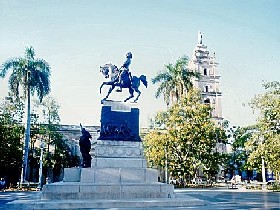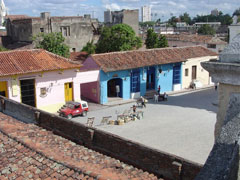|
ARCHIPIÉLAGO SABANA-CAMAGÜEY
 This is the largest archipelago of those that surround the island of Cuba and is part of the province of Ciego de Ávila. The most famous, the Gardens of the King (Jardines del Rey) is of astounding beauty and is one of the main tourist destinies of beaches in the country.
Its marine bottoms are protected by a coral reef that is the second most extensive in the world, because the first is in Australia.
Among the Jardines del Rey, the most well known destinies are Cayo Coco, from where the coconut bird, also known as white ibis can be seen, and Cayo Guillermo, with the pleasant presence of pink flamencos. It is an isle of 13 square kilometres and features one of the highest dunes in the world, reaching up to 15 meters height.
The archipelago is connected by land to the larger island of Cuba and an airport with a capacity of receiving medium size and small planes is also located here.
This is the largest archipelago of those that surround the island of Cuba and is part of the province of Ciego de Ávila. The most famous, the Gardens of the King (Jardines del Rey) is of astounding beauty and is one of the main tourist destinies of beaches in the country.
Its marine bottoms are protected by a coral reef that is the second most extensive in the world, because the first is in Australia.
Among the Jardines del Rey, the most well known destinies are Cayo Coco, from where the coconut bird, also known as white ibis can be seen, and Cayo Guillermo, with the pleasant presence of pink flamencos. It is an isle of 13 square kilometres and features one of the highest dunes in the world, reaching up to 15 meters height.
The archipelago is connected by land to the larger island of Cuba and an airport with a capacity of receiving medium size and small planes is also located here.
Pour davantage d'information:
www.cuba-cayococo.com
,
www.cuba-cayoguillermo.com
,
www.cuba-cayolevisa.com
,
www.cuba-ciegodeavila.com
,
www.cuba-jardinesdelrey.com
|
|
|
CAMAGÜEY
 Appelée Santa María del Puerto del Príncipe à l’origine, elle fut une des sept premières villes fondées par les espagnols et son viendrait apparemment du mot Camaguebax, nom d’un chef indigène.
Aussi connue comme ville des « tinajones » (très grandes jarres de poterie servant à accumuler l’eau de pluie), est élevée entre les fleuves Tínima et Hatibonico.
Des maisons et de grandes demeures, y compris de deux siècle en arrière y sont conservées.
LA ville possède aussi des édifices religieux, entre autres, La Cathédrale, les églises « del Carmen » et Sainte Anne, faisant toutes partie du centre historique déclaré patrimoine de l’humanité.
Les rues du centre historique sont étroites et sinueuses et pour cela, sont en contraste avec les constructions urbaines qui surgirent pendant les dernières décennies.
Le Centre Champêtre, construit au 19ème siècle comme espace destiné aux foires agricoles, est aujourd’hui devenu le poumon vert de la ville.
Le carnaval en honneur à San Juan est très attractif, son origine remonte au 17ème siècle.
Le festival national de théâtre à lieu tout les deux ans dans cette ville qui est aussi le siège de la compagnie de danse du même nom laquelle est la deuxième plus importante du pays.
Appelée Santa María del Puerto del Príncipe à l’origine, elle fut une des sept premières villes fondées par les espagnols et son viendrait apparemment du mot Camaguebax, nom d’un chef indigène.
Aussi connue comme ville des « tinajones » (très grandes jarres de poterie servant à accumuler l’eau de pluie), est élevée entre les fleuves Tínima et Hatibonico.
Des maisons et de grandes demeures, y compris de deux siècle en arrière y sont conservées.
LA ville possède aussi des édifices religieux, entre autres, La Cathédrale, les églises « del Carmen » et Sainte Anne, faisant toutes partie du centre historique déclaré patrimoine de l’humanité.
Les rues du centre historique sont étroites et sinueuses et pour cela, sont en contraste avec les constructions urbaines qui surgirent pendant les dernières décennies.
Le Centre Champêtre, construit au 19ème siècle comme espace destiné aux foires agricoles, est aujourd’hui devenu le poumon vert de la ville.
Le carnaval en honneur à San Juan est très attractif, son origine remonte au 17ème siècle.
Le festival national de théâtre à lieu tout les deux ans dans cette ville qui est aussi le siège de la compagnie de danse du même nom laquelle est la deuxième plus importante du pays.
Pour davantage d'information:
www.cuba-cayosabinal.com
,
www.cuba-santalucia.com
,
www.cuba-camaguey.com
|
|
|
JIMAGUAYÚ
The war was reinforced in the eastern provinces of Oriente, Camagüey and Las Villas, during the days of September 13 to 16th of 1895, due to the fact that a meeting was held in Jimaguayú, a historical site of the restructuring by Agramonte. The representatives of the Cuban revolutionaries in arms gathered in order to establish the laws by which the young Revolution would continue its path to victory.
It was General Máximo Gómez who chose the spot, it was where in 1873 Major General Ignacio Agramonte fell in brutal combat for freedom.
Here, the illustrious Dominican placed his troops in order to protect those that were to reflect on the Carta Magna, a document that would succeed the Guáimaro Constitution of 1869.
Everything was ready so that the chosen patriots were able to constitute the Revolutionary Parliament in Jimaguayú, whose sessions were held in a humble “bohio” made of palm leaves, under the presidency of Salvador Cisneros Betancourt.
The Constitution of Jimaguayú established, like its predecessor of Guaímaro in 1869, a centralised government of the Republic, but unlike its predecessor, it joined the legislative and executive powers in one legal body.
This reduced the size of the power structure which allowed faster decisions to be made on issues of the State, a result of the experiences of the Ten Year War (Guerra de los 10 Años).
Pour davantage d'information:
www.cuba-heroes.com
,
www.cuba-history.com
,
www.cuba-camaguey.com
,
www.aboutcuba.com
|
|
|
NUEVITAS
À été fondée officiellement comme ville en 1818, bien que son histoire remonte au 18 novembre 1494 quand Christophe Colomb marcha sur ses terres et dans un lieu plaisant et dépourvu d’arbres, il planta une grande croix. Au même moment il baptisa le lieu avec le nom de « Puerto Principe », ainsi qu’un groupe d’îlots qu’il nomma les « Jardines del Rey » (Les Jardins du Roi) et le golf dans lequel il se trouvait : « Mar de nuestra Señora » (Mer de notre Mère).
Le territoire couvre une superficie de 1.948 Kilomètres carrés et possède une jolie baie ainsi qu’un développement industriel notable avec la production de ciment comme fer de lance dans les indices économiques soutenus. Pour l’histoire et les paysages attrayant qu’elle offre au visiteur, ainsi que pour la belle combinaison du bleu marin et de la verte végétation, Nuevitas mérite d’être incluse dans les destinations de la province de Camagüey.
Pour davantage d'information:
www.cuba-cayosabinal.com
,
www.cuba-santalucia.com
,
www.cuba-camaguey.com
|
|
|
PLACE “SAN JUAN DE DIOS”
 L’existence de cet inégalable lieu dans la ville de Camagüey date du 18ème siècle (1728), selon les documents de l’ancien bourg de Santa Maria del Puerto del Principe. Le nom de l’ensemble architectural vient de l’ordre des Frères de San Juan de Dios (Saint Jean de Dieu). La majestueuse architecture coloniale qui est conservée là bas et maintient une bonne partie de la ville légendaire et la place pavée fait partie de l’environnement, près de l’ancien hôpital, une église et les maisons, deux d’entre elles converties en restaurants. On arrive sur ce lieu depuis la fameuse Place des Travailleurs après une courte promenade par les rues sinueuses et une fois sur place, le visiteurs est capté par la singulière beauté du lieu où s’harmonisent sculptures, peintures et autres projets qui peu à peu prennent plus de force en bénéfice de la petite place bien conservée qui possède le bien mérité titre de Monument National.
L’existence de cet inégalable lieu dans la ville de Camagüey date du 18ème siècle (1728), selon les documents de l’ancien bourg de Santa Maria del Puerto del Principe. Le nom de l’ensemble architectural vient de l’ordre des Frères de San Juan de Dios (Saint Jean de Dieu). La majestueuse architecture coloniale qui est conservée là bas et maintient une bonne partie de la ville légendaire et la place pavée fait partie de l’environnement, près de l’ancien hôpital, une église et les maisons, deux d’entre elles converties en restaurants. On arrive sur ce lieu depuis la fameuse Place des Travailleurs après une courte promenade par les rues sinueuses et une fois sur place, le visiteurs est capté par la singulière beauté du lieu où s’harmonisent sculptures, peintures et autres projets qui peu à peu prennent plus de force en bénéfice de la petite place bien conservée qui possède le bien mérité titre de Monument National.
Pour davantage d'information:
www.cuba-history.com
,
www.cuba-camaguey.com
|
|
|
THE PLACE WHERE THE GUAIMARO ASSEMBLY (ASAMBLEA DE GUÁIMARO) WAS HELD
As an adequate precursor for such great history, the first Constitution of the Republic in Arms was held at Guáimaro, a territory located east of Camagüey, where the main protagonists of the insurrection met in April of 1869, only a few months after the beginning of the first struggle for the nation’s freedom.
In this encounter, in which the bravest representatives of independence took part, the necessary unity within the revolution prevailed against the different ideas that had been maintained up to the moment in the field of insurrection.
The opinions of Carlos Manuel de Céspedes on one united leadership, where the civilian and military roles were controlled by the same person, were opposed to the opinions of those from Camaguey, who thought it was prudent to separate both roles, with an internal division of the civilian command.
Imagine for an instant those men of strict personality, most of them educated in the best colleges of the country and in foreign parts as well, decided on risking their lives and wealth in the struggle, firm and convinced of their own ideas.
They defended their ideas with ardour and bravery, and we can visualise the intense panorama of the Guaimaro Assembly sessions (Asamblea de Guáimaro).
Finally, the firm and coherent block made up of those from Camaguey and Villa Clara prevailed, in which the young lawyer Ignacio Agramonte y Loynaz played quite a part, and from whose pen the project of the Constitution was born.
Pour davantage d'information:
www.cuba-heroes.com
,
www.cuba-history.com
,
www.cuba-camaguey.com
,
www.aboutcuba.com
|
|